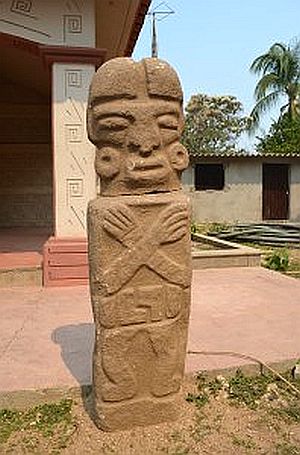Guerrero, Mexico - Villagers installing a water pipe a few weeks ago in the town of Piedra Labrada - located in southwestern Mexico near the Guatemalan border - unearthed a granite statue depicting a player of a Mesoamerican ball game.
The figure is 5’4" high when including the head - which had been sliced at the neck, like a decapitation, and buried. Archaeologists believe it was deliberately severed from the body during an ancient ball game ritual.
The stele portrays a bow-legged ballplayer with his arm crossed over his chest. He is accessorized with a helmet, a yoke around his waist and round stones, possibly the precious greenstones known as chalchihuites, hanging from his ears.
The statue was discovered in the north section of the town on the grounds of the biggest ball game field, an L-shaped court about 130 feet long. There are five ball courts in Piedra Labrada. Around twenty sculptures of snake heads, shells, and anthropomorphic figures were found in three of them, but this is the first sculpture found in the north field and the only one that depicts a ball player.
The Mesoamerican ball game was not simply a sport. The basic game fielded two teams who sought to put a rubber ball through a stone circle by bouncing it off their hips, but it was also an immensely important religious ritual with a number of ceremonial functions.
Among these rites was a ritual marking the end of a calendar cycle during which sculptures were painted red and then ceremonially "killed" by having their heads cut off. The decapitated statues would then be buried around the court.
The age of the stele is hard to pinpoint because Piedra Labrada has not been thoroughly excavated. Since the recent digs began a year and a half ago, archaeologists have been mapping the site. The pre-Hispanic town is 1.24 square miles in area.
In addition to the five ball fields, almost 50 medium-sized buildings, 10-16 feet high, have been identified; as well as public plazas and sculptures. The sculptures that have been found thus far appear to be Mixtec (an indigenous ethnic group who have a documented history going back to 940 AD) in design, and their placement in the ancient town is characteristic of that culture - which could turn the clock all the way back to 600 AD.
Given the breadth of these discoveries - the many buildings, the ball courts, the big public squares, and now the unique ball player statue - there’s little doubt that Piedra Labrada was an important Mesoamerican city; a ritual center if not a political and population center.
Archaeologists have submitted a proposal to the Archaeology Council of Mexico’s National Institute of Anthropology and History for an extensive excavation project that might reveal more information about the ancient city, its dates of use, and the people who worshiped there. They’re hoping to unearth ceramics that can be dated and analyzed to determine their origin.If the project is authorized, it will be the first major archaeological exploration in the Costa Chica area of the Guerrero region.
Since many of the pre-Hispanic sites in this area are intact, there could be a wealth of new information about the Mixtec and other local Mesoamerican groups to be discovered. For now the stele is being kept in the municipal police station.
Source: TheHistoryBlog.com


